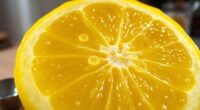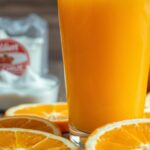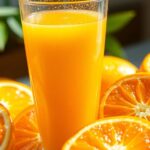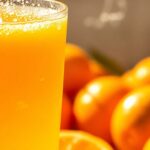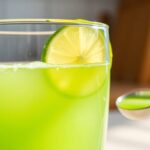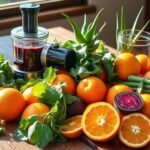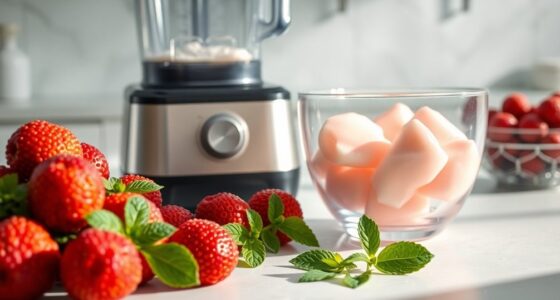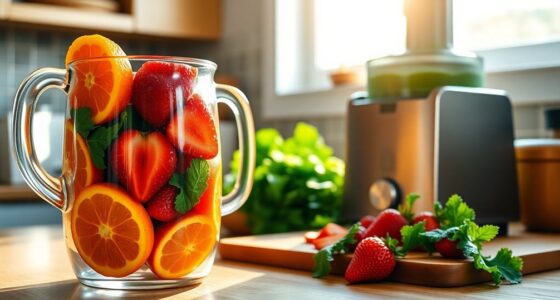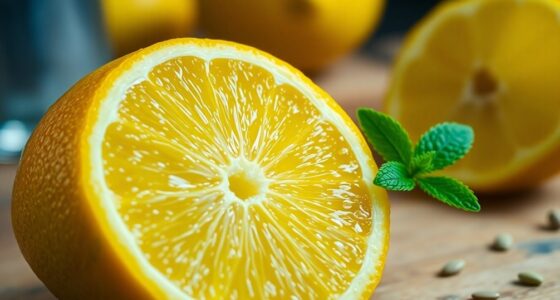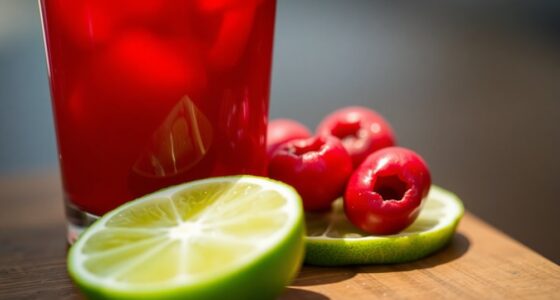Orange juice contains about 0.21 milligrams of iron per cup, which is roughly 1% of the daily iron value for an average adult. While it offers a small amount of iron, it shouldn't be your primary source. Freshly squeezed and store-bought varieties have similar low iron content. To enhance iron absorption, pair vitamin C-rich foods like orange juice with iron-rich options. If you want to learn more about iron sources and their importance, keep going!
Key Takeaways
- One cup of orange juice contains approximately 0.21 milligrams of iron, which is about 1% of the daily value for iron.
- Iron content in orange juice is low compared to other dietary sources like red meat, beans, and dark green vegetables.
- Freshly squeezed and store-bought orange juice have similar iron levels, with variations based on juice type and processing methods.
- Vitamin C in orange juice can enhance the absorption of nonheme iron from other foods when consumed together.
- It's not recommended to rely solely on orange juice for iron intake; a varied diet is essential for meeting iron needs.
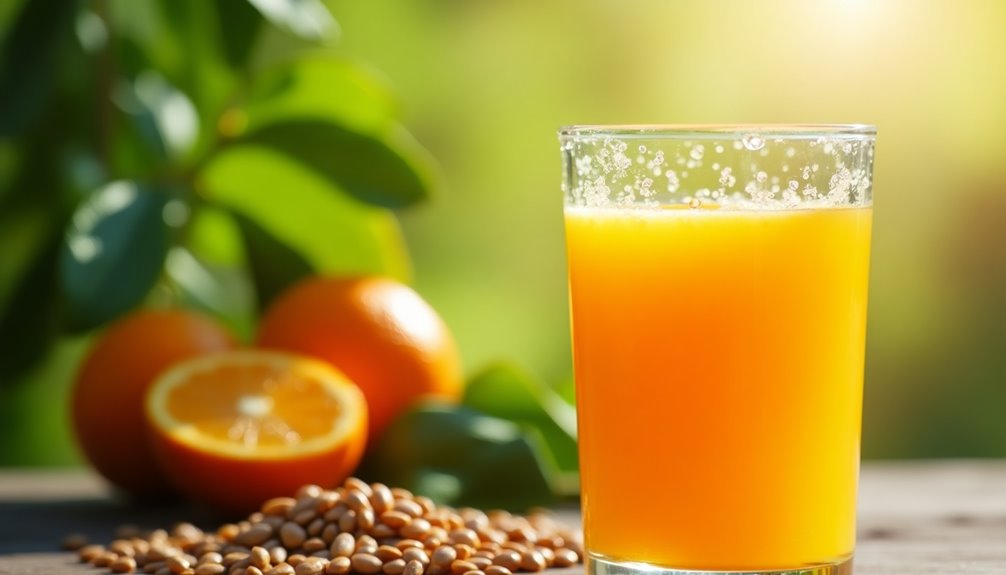
Have you ever wondered how much iron is in your morning glass of orange juice? If you're like many people, you might expect it to be a good source of this essential mineral, especially since it's often part of a healthy breakfast. However, the reality is quite different. One cup of orange juice contains approximately 0.21 milligrams of iron, which is about 1% of the daily value for iron based on a typical 2,000 calorie diet. This isn't a significant amount, especially when you consider that iron is crucial for the production of red blood cells and overall health.
The iron content in orange juice can vary based on several factors, including the type of juice and the processing methods used. While freshly squeezed orange juice typically has a similar low iron content as store-bought varieties, the specific orange variety can also play a role. Regardless of how you get your juice, you can expect it to offer minimal amounts of iron compared to other dietary options. Foods like red meat, beans, and dark green vegetables are far better sources for your daily iron needs.
So, why does iron matter? Iron is essential for everyone, but children are particularly susceptible to iron deficiency. This deficiency can lead to anemia, which can hinder their development and energy levels. While it's crucial for kids to get enough iron, relying solely on fruit juice like orange juice isn't the way to go. If you're concerned about your child's iron intake, it's better to focus on foods known for their high nonheme iron content.
Now, let's talk about absorption. Even though orange juice is low in iron, it does have a trick up its sleeve. It's rich in vitamin C, which significantly enhances the absorption of nonheme iron from plant-based sources when consumed together. So, if your breakfast includes oatmeal or spinach, washing it down with a glass of orange juice can help your body absorb more of the iron from those foods.
Still, it's important to remember that while orange juice can aid in the absorption of iron, it's not a significant source itself. If you're trying to boost your iron levels, consider incorporating a variety of foods into your diet. Pairing vitamin C-rich foods like orange juice with iron-rich options can be beneficial, but don't rely solely on fruit juice for your iron needs.
Frequently Asked Questions
Is Orange Juice High in Iron?
No, orange juice isn't high in iron. While it contains a small amount—about 0.21 milligrams per cup—this is only about 1% of your daily iron needs.
Compared to other sources like red meat and legumes, it's relatively low. However, orange juice is rich in vitamin C, which can help you absorb nonheme iron from plant-based foods better.
What Drink Is the Highest in Iron?
When you're looking for drinks high in iron, beef broth tops the list with about 1.7 mg per cup.
Prune juice follows closely, offering around 0.81 mg.
If you enjoy cocoa, a cup made with natural cocoa powder can provide approximately 0.3 mg of iron.
Beet juice comes in lower at about 0.2 mg.
What Raises Iron Quickly?
Imagine a garden bursting with vibrant greens and juicy oranges, where your iron levels can rise like the sun.
To boost your iron quickly, munch on heme sources like red meat or poultry, since your body absorbs them efficiently.
Pair nonheme sources, like beans or spinach, with vitamin C-rich foods, like citrus fruits, to enhance absorption.
Don't forget iron-fortified cereals and supplements; they can also help you reach your iron goals fast.
Is 65 Mg of Iron a Day Too Much?
Yes, 65 mg of iron a day is too much for most adults.
The upper intake level for iron is set at 45 mg, and exceeding this can lead to toxicity and serious health risks, like liver damage and gastrointestinal issues.
If you're considering high iron intake, it's crucial to consult a healthcare professional. They can help you assess your needs and avoid potential complications from iron overload.
Conclusion
In the world of nutrition, orange juice shines bright with vitamin C but falls short in iron content. While a tall glass invigorates your immune system, it offers only a modest amount of iron, about 0. 2 mg per 100 ml. So, if you’re looking for a hearty iron boost, you might want to pair your juice with iron-rich foods like spinach or beans. Enjoy the refreshing taste, but don’t forget to balance your diet for optimal health! Moreover, diversifying your beverage choices can enhance your overall nutrient intake. For instance, if you enjoy grapefruit juice, consider how much grapefruit juice is used as a complement to your meals; it also contains vitamin C and can aid in the absorption of iron. Ultimately, a well-rounded diet with a variety of fruits, vegetables, and iron sources will ensure that you meet your nutritional needs effectively.
Cindy thoroughly researches juicing trends, techniques, and recipes to provide readers with practical advice and inspiration. Her writing style is accessible, engaging, and designed to make complex concepts easy to understand. Cindy’s dedication to promoting the advantages of juicing shines through her work, empowering readers to make positive changes in their lives through the simple act of juicing.


